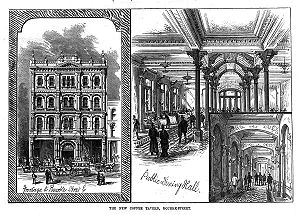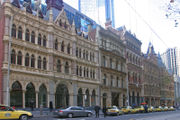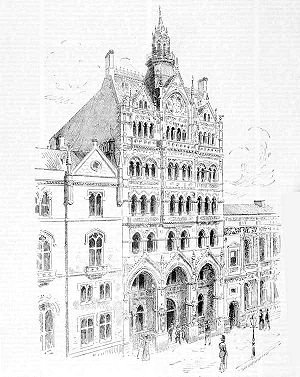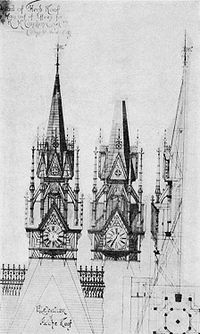.gif)
William Pitt (architect)
Encyclopedia
William Pitt born in Melbourne
was an architect
, public servant and politician
working in Victoria, Australia in the later part of the 19th century and early 20th century.
Although some of his grandest buildings have since been demolished including the Melbourne Coffee Palace (1879) and the Federal Coffee Palace (1888), some examples of Pitt's architectural work remains today and he is still strongly associated with the boom era of Marvellous Melbourne.
Pitt's roots were in the suburb of St Kilda
, he lived, was educated there and died there for some time and one of his finest contributions and surviving architectural works, the St Kilda Town Hall
is one of the landmarks of the area (although his original vision for the building was never fully realised).
Pitt began his own architectural practice in 1879 and he became highly sought after during the land boom in Melbourne, working almost solely in commercial architecture and becoming one of the a prolific proponent of eclecticism
, in particular the Gothic revival
and Second Empire styles of architecture
. His legacy can be seen in grand commercial buildings lining Collins Street, Melbourne
.
Pitt was also renowned in Australasia
as a specialist in theatre
design, particularly in interiors with works in Melbourne, Ballarat, Sydney
, Adelaide
, Wellington
and Auckland
. Some declared him at the time to be the greatest theatre architect in Australia.
.
He was raised in the suburb of St Kilda
and was educated at the Hofwyl School in St Kilda and later attended George Henry Neighbour's college in Carlton
. He later moved to the suburb of Abbotsford
.



 Pitt began his architecture career as an understudy in 1875.
Pitt began his architecture career as an understudy in 1875.
He began his own architectural practice in 1879 and got his first break with the major commission for the Melbourne Coffee Palace (1879) (once located on Bourke Street between Swanton and Russell) which he was awarded as first prize of an architectural competition.
In 1880, Pitt was again awarded first prize for his design of Queens Bridge
over the Yarra River
.
These buildings and the Premier Permanent Building Society on Collins Street showed an early preference for classically inspired styles.
He received an award for his design of the Gordon House apartments which he designed in 1883 (1884) in Little Bourke Street
. It was the first of his designs to flirt with the gothic style.
Pitt began to work in theatres in the mid 1880s, with his greatest, the Princess Theatre
(1886) in the Second Empire style, in Spring Street
being one of the few to have survived. His concept for the theatre's sliding roof was a world first.
In 1887, Pitt was appointed vice-president of the Victorian Institute of Architects. It was during this time that the size of his projects significantly increased and he was given the freedom to experiment with eclecticism and in particular the gothic style. It followed that his largest commission and most ambitious design was the Federal Coffee Palace
at the south-west corner of King Street
and Collins Street. While he received a second prize for his design, he was allowed to collaborate with the winners, Ellerker & Kilburn and the result was a composite design. The massive and outlandish building had references to numerous architectural styles and was both hailed and criticised for its extraordinary ebullience. Although Pitt was a joint architect, many attribute the design to him, feeling that his ideas had a dominant influence. The building came to epitomise the speculative land boom which was 'Marvellous Melbourne' of the late 1880s and it was completed in 1888.
Pitt's extensive work in Gothic revival
featured some surviving examples in the Venetian Gothic
idiom. The Olderfleet (1888) the nearby Old Stock Exchange (1888) and Rialto Buildings (1889) in Collins Street
are on the Victorian Heritage Register
. His polychromatic design of the 3 storey Denton Hat Mills (1888) in Abbotsford, Victoria
began his specialisation in warehouse architecture. He was also credited with the design of Brunswick Town Hall
in 1889.
In 1890, the Venetian gothic Old Safe Deposit Building on Queen Street
was to follow, and the Markilles Hotel on Flinders Street
.
Pitt suffered a massive financial setback during the financial crisis of 1890, during which he declared bankruptcy. Nevertheless, he was made commissioner Melbourne Board of Works
1891.
Tower House (1891), a fanciful combination of Tudor, Queen Anne and Mannerist styles was once a landmark on the corners of Spring and Flinders Streets.
In 1892, he showed his passionate support for the Collingwood Football Club
by designing a grandstand for Victoria Park
for free.
He followed with the distinctively castellated design of the Victoria Brewery (1896) on Victoria Parade in East Melbourne.
including being an active member of the Australian Natives Association
and also the Freemasons.
He was first elected to the City of Collingwood
's council in 1888 and became mayor in 1890 and served also in 1891 before retiring from council in 1894.
He was also a member of the Victorian Legislative Council
Northern Province between 1891 and 1904 and for the Eastern Province in 1904-10. Pitt was a vocal supporter of the Australian Federation Movement
.
Pitt was made chairman of the Melbourne Harbor Trust in 1901 and served until 1905.
A rare foray into residential architecture with the design of Avalon Mansion (1903) at 70 Queens Road. He also redesigned the interior of Her Majesty's Theatre, Sydney
in 1903.
Hi design throughput increased at the turn of the decade and among his subsequent projects included surviving buildings such as the Empire Works
(later Bryant and May factory) (1909) in inner suburban Richmond
, the Victorian Racing Club (1910) on Collins Street (demolished), , Wellington Opera House (1911) and Sir Charles Hotham Hotel (1912), which survives on the corner of Spencer and Flinders Streets as a backpacker hostel.
Melbourne
Melbourne is the capital and most populous city in the state of Victoria, and the second most populous city in Australia. The Melbourne City Centre is the hub of the greater metropolitan area and the Census statistical division—of which "Melbourne" is the common name. As of June 2009, the greater...
was an architect
Architect
An architect is a person trained in the planning, design and oversight of the construction of buildings. To practice architecture means to offer or render services in connection with the design and construction of a building, or group of buildings and the space within the site surrounding the...
, public servant and politician
Politician
A politician, political leader, or political figure is an individual who is involved in influencing public policy and decision making...
working in Victoria, Australia in the later part of the 19th century and early 20th century.
Although some of his grandest buildings have since been demolished including the Melbourne Coffee Palace (1879) and the Federal Coffee Palace (1888), some examples of Pitt's architectural work remains today and he is still strongly associated with the boom era of Marvellous Melbourne.
Pitt's roots were in the suburb of St Kilda
St Kilda, Victoria
St Kilda is an inner city suburb of Melbourne, Victoria, Australia, 6 km south from Melbourne's central business district. Its Local Government Area is the City of Port Phillip...
, he lived, was educated there and died there for some time and one of his finest contributions and surviving architectural works, the St Kilda Town Hall
St Kilda Town Hall
St Kilda Town Hall is a city hall in St Kilda, Victoria, Australia.-Architecture:The design by local architect William Pitt in the Classical Revival style. It was built in 1890. Pitt's grand vision for the town hall was never completed...
is one of the landmarks of the area (although his original vision for the building was never fully realised).
Pitt began his own architectural practice in 1879 and he became highly sought after during the land boom in Melbourne, working almost solely in commercial architecture and becoming one of the a prolific proponent of eclecticism
Eclecticism
Eclecticism is a conceptual approach that does not hold rigidly to a single paradigm or set of assumptions, but instead draws upon multiple theories, styles, or ideas to gain complementary insights into a subject, or applies different theories in particular cases.It can sometimes seem inelegant or...
, in particular the Gothic revival
Gothic Revival architecture
The Gothic Revival is an architectural movement that began in the 1740s in England...
and Second Empire styles of architecture
Architectural style
Architectural styles classify architecture in terms of the use of form, techniques, materials, time period, region and other stylistic influences. It overlaps with, and emerges from the study of the evolution and history of architecture...
. His legacy can be seen in grand commercial buildings lining Collins Street, Melbourne
Collins Street, Melbourne
Collins Street is a major street in the Melbourne central business district and runs approximately east to west.It is notable as Melbourne's traditional main street and best known street, is often regarded as Australia's premier street, with some of the country's finest Victorian era buildings.The...
.
Pitt was also renowned in Australasia
Australasia
Australasia is a region of Oceania comprising Australia, New Zealand, the island of New Guinea, and neighbouring islands in the Pacific Ocean. The term was coined by Charles de Brosses in Histoire des navigations aux terres australes...
as a specialist in theatre
Theatre
Theatre is a collaborative form of fine art that uses live performers to present the experience of a real or imagined event before a live audience in a specific place. The performers may communicate this experience to the audience through combinations of gesture, speech, song, music or dance...
design, particularly in interiors with works in Melbourne, Ballarat, Sydney
Sydney
Sydney is the most populous city in Australia and the state capital of New South Wales. Sydney is located on Australia's south-east coast of the Tasman Sea. As of June 2010, the greater metropolitan area had an approximate population of 4.6 million people...
, Adelaide
Adelaide
Adelaide is the capital city of South Australia and the fifth-largest city in Australia. Adelaide has an estimated population of more than 1.2 million...
, Wellington
Wellington
Wellington is the capital city and third most populous urban area of New Zealand, although it is likely to have surpassed Christchurch due to the exodus following the Canterbury Earthquake. It is at the southwestern tip of the North Island, between Cook Strait and the Rimutaka Range...
and Auckland
Auckland
The Auckland metropolitan area , in the North Island of New Zealand, is the largest and most populous urban area in the country with residents, percent of the country's population. Auckland also has the largest Polynesian population of any city in the world...
. Some declared him at the time to be the greatest theatre architect in Australia.
Early life
William Pitt was born in 1855 two years after his parents William Pitt, an artist, and Jane, née Dixon emigrated to Australia from Sunderland in EnglandEngland
England is a country that is part of the United Kingdom. It shares land borders with Scotland to the north and Wales to the west; the Irish Sea is to the north west, the Celtic Sea to the south west, with the North Sea to the east and the English Channel to the south separating it from continental...
.
He was raised in the suburb of St Kilda
St Kilda, Victoria
St Kilda is an inner city suburb of Melbourne, Victoria, Australia, 6 km south from Melbourne's central business district. Its Local Government Area is the City of Port Phillip...
and was educated at the Hofwyl School in St Kilda and later attended George Henry Neighbour's college in Carlton
Carlton, Victoria
Carlton is an inner city suburb of Melbourne, Victoria, Australia, 2 km north from Melbourne's central business district. Its Local Government Area is the City of Melbourne...
. He later moved to the suburb of Abbotsford
Abbotsford, Victoria
Abbotsford is a suburb in Melbourne, Victoria, Australia, 2 km east from Melbourne's central business district. Its Local Government Area is the City of Yarra. At the 2006 Census, Abbotsford had a population of 4,327....
.
Architect career




He began his own architectural practice in 1879 and got his first break with the major commission for the Melbourne Coffee Palace (1879) (once located on Bourke Street between Swanton and Russell) which he was awarded as first prize of an architectural competition.
In 1880, Pitt was again awarded first prize for his design of Queens Bridge
Queens Bridge (Melbourne)
The Queens Bridge is a historic road bridge over the Yarra River in Melbourne, Victoria, Australia. The bridge was built in 1889 and has five wrought iron plate girder spans, and is listed on the Victorian Heritage Register...
over the Yarra River
Yarra River
The Yarra River, originally Birrarung, is a river in east-central Victoria, Australia. The lower stretches of the river is where the city of Melbourne was established in 1835 and today Greater Melbourne dominates and influences the landscape of its lower reaches...
.
These buildings and the Premier Permanent Building Society on Collins Street showed an early preference for classically inspired styles.
He received an award for his design of the Gordon House apartments which he designed in 1883 (1884) in Little Bourke Street
Little Bourke Street, Melbourne
Little Bourke Street in Melbourne's CBD runs roughly east–west within the Hoddle Grid. It is a one-way street heading in a westward direction...
. It was the first of his designs to flirt with the gothic style.
Pitt began to work in theatres in the mid 1880s, with his greatest, the Princess Theatre
Princess Theatre, Melbourne
The Princess Theatre is a 1488-seat theatre in Melbourne, Australia.It is listed by the National Trust of Australia and is on the Victorian Heritage Register.-History:...
(1886) in the Second Empire style, in Spring Street
Spring Street, Melbourne
Spring Street is a major street in the central business district of Melbourne, Victoria, Australia. It runs roughly north-south, and is the easternmost street in the Hoddle Grid. The street travels from Flinders Street in the south, to La Trobe Street and the Carlton Gardens in the north...
being one of the few to have survived. His concept for the theatre's sliding roof was a world first.
In 1887, Pitt was appointed vice-president of the Victorian Institute of Architects. It was during this time that the size of his projects significantly increased and he was given the freedom to experiment with eclecticism and in particular the gothic style. It followed that his largest commission and most ambitious design was the Federal Coffee Palace
Coffee Palace
The term Coffee Palace was primarily used in Australia to describe the temperance hotels which were built during the period of the 1880s although there are references to the term also being used, to a lesser extent, in the United Kingdom...
at the south-west corner of King Street
King Street, Melbourne
King Street is a main street in the Melbourne central business district. King Street is part of the Pacific Highway, and used to be part of National Route 1 until the city by-pass road linking the Monash Freeway with the Westgate Freeway was completed...
and Collins Street. While he received a second prize for his design, he was allowed to collaborate with the winners, Ellerker & Kilburn and the result was a composite design. The massive and outlandish building had references to numerous architectural styles and was both hailed and criticised for its extraordinary ebullience. Although Pitt was a joint architect, many attribute the design to him, feeling that his ideas had a dominant influence. The building came to epitomise the speculative land boom which was 'Marvellous Melbourne' of the late 1880s and it was completed in 1888.
Pitt's extensive work in Gothic revival
Gothic Revival architecture
The Gothic Revival is an architectural movement that began in the 1740s in England...
featured some surviving examples in the Venetian Gothic
Venetian Gothic architecture
Venetian Gothic is a term given to an architectural style combining use of the Gothic lancet arch with Byzantine and Moorish architecture influences. The style originated in 14th century Venice with the confluence of Byzantine styles from Constantinople, Arab influences from Moorish Spain and early...
idiom. The Olderfleet (1888) the nearby Old Stock Exchange (1888) and Rialto Buildings (1889) in Collins Street
Collins Street, Melbourne
Collins Street is a major street in the Melbourne central business district and runs approximately east to west.It is notable as Melbourne's traditional main street and best known street, is often regarded as Australia's premier street, with some of the country's finest Victorian era buildings.The...
are on the Victorian Heritage Register
Victorian Heritage Register
The Victorian Heritage Register lists places of cultural heritage significance to the State of Victoria, Australia. It has statutory weight under the Heritage Act 1995 which establishes Heritage Victoria as the permit authority...
. His polychromatic design of the 3 storey Denton Hat Mills (1888) in Abbotsford, Victoria
Abbotsford, Victoria
Abbotsford is a suburb in Melbourne, Victoria, Australia, 2 km east from Melbourne's central business district. Its Local Government Area is the City of Yarra. At the 2006 Census, Abbotsford had a population of 4,327....
began his specialisation in warehouse architecture. He was also credited with the design of Brunswick Town Hall
Brunswick Town Hall
Brunswick Town Hall is located on the corner of Dawson Street and Sydney Road in the inner northern Melbourne, suburb of Brunswick, Victoria, Australia....
in 1889.
In 1890, the Venetian gothic Old Safe Deposit Building on Queen Street
Queen Street, Melbourne
Queen Street is a street in the Melbourne central business district, forming part of the famous Hoddle Grid. It runs roughly from north to south. The northern end of Queen Street intersects with Victoria Street, while its southern end intersects with Flinders Street...
was to follow, and the Markilles Hotel on Flinders Street
Flinders Street, Melbourne
Flinders Street is a notable street in Melbourne, Victoria, Australia. Running roughly parallel to the Yarra River, Flinders Street forms the southern edge of the Hoddle Grid. It is exactly one mile in length and one and half chains in width...
.
Pitt suffered a massive financial setback during the financial crisis of 1890, during which he declared bankruptcy. Nevertheless, he was made commissioner Melbourne Board of Works
Melbourne and Metropolitan Board of Works
The Melbourne and Metropolitan Board of Works was a public utility board in Melbourne, Australia set up to provide water supply, sewerage and sewage treatment functions for the city...
1891.
Tower House (1891), a fanciful combination of Tudor, Queen Anne and Mannerist styles was once a landmark on the corners of Spring and Flinders Streets.
In 1892, he showed his passionate support for the Collingwood Football Club
Collingwood Football Club
The Collingwood Football Club, nicknamed The Magpies, is an Australian rules football club which plays in the Australian Football League...
by designing a grandstand for Victoria Park
Victoria Park, Melbourne
Victoria Park is a sports venue in Abbotsford a suburb of Melbourne in Victoria, Australia. Built for the purpose of both Australian rules football and cricket, the stadium is oval shaped....
for free.
He followed with the distinctively castellated design of the Victoria Brewery (1896) on Victoria Parade in East Melbourne.
Politics and Public Service
Throughout his life, Pitt had strong political aspirations. He was known to participate in various fraternitiesFraternity
A fraternity is a brotherhood, though the term usually connotes a distinct or formal organization. An organization referred to as a fraternity may be a:*Secret society*Chivalric order*Benefit society*Friendly society*Social club*Trade union...
including being an active member of the Australian Natives Association
Australian Natives Association
The Australian Natives' Association , a mutual society was founded in Melbourne, Australia in April 1871. The Association played a leading role in the movement for Australian federation in the last 20 years of the 19th century. In 1900 it had a membership of 17,000, mainly in Victoria.The ANA...
and also the Freemasons.
He was first elected to the City of Collingwood
City of Collingwood
The City of Collingwood was a Local Government Area located about east-northeast of Melbourne, the state capital of Victoria, Australia. The city covered an area of , and existed from 1855 until 1994.-History:...
's council in 1888 and became mayor in 1890 and served also in 1891 before retiring from council in 1894.
He was also a member of the Victorian Legislative Council
Victorian Legislative Council
The Victorian Legislative Council, is the upper of the two houses of the Parliament of Victoria, Australia; the lower house being the Legislative Assembly. Both houses sit in Parliament House in Spring Street, Melbourne. The Legislative Council serves as a house of review, in a similar fashion to...
Northern Province between 1891 and 1904 and for the Eastern Province in 1904-10. Pitt was a vocal supporter of the Australian Federation Movement
Federation of Australia
The Federation of Australia was the process by which the six separate British self-governing colonies of New South Wales, Queensland, South Australia, Tasmania, Victoria and Western Australia formed one nation...
.
Pitt was made chairman of the Melbourne Harbor Trust in 1901 and served until 1905.
A rare foray into residential architecture with the design of Avalon Mansion (1903) at 70 Queens Road. He also redesigned the interior of Her Majesty's Theatre, Sydney
Her Majesty's Theatre, Sydney
Her Majesty's Theatre, Sydney, Australia, refers to three theatres of the same name:One was a theatre which opened on 10 September 1887 and closed on 10 June 1933.It was located on the corner of Pitt and Market Street, Sydney, where Centrepoint stands today....
in 1903.
Hi design throughput increased at the turn of the decade and among his subsequent projects included surviving buildings such as the Empire Works
Bryant and May Factory, Melbourne
The Bryant and May Factory is located in the suburb of Cremorne in Melbourne, Australia. It was constructed in 1909 as the Empire Works to a design by prolific Melbourne architect William Pitt...
(later Bryant and May factory) (1909) in inner suburban Richmond
Richmond, Victoria
Richmond is a suburb in Melbourne, Victoria, Australia, 3 km south-east from Melbourne's central business district. Its Local Government Area is the City of Yarra...
, the Victorian Racing Club (1910) on Collins Street (demolished), , Wellington Opera House (1911) and Sir Charles Hotham Hotel (1912), which survives on the corner of Spencer and Flinders Streets as a backpacker hostel.

